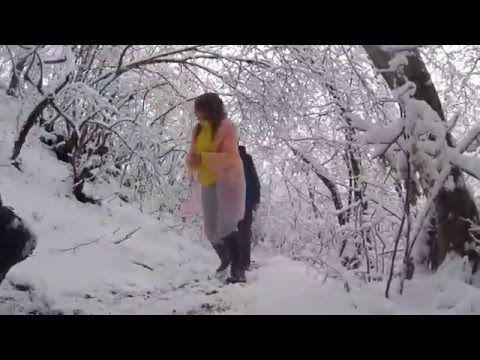Bochorma Fortress / ბოჭორმის ციხე / Крепостъ Бочорма / - 4K aerial video footage DJI Inspire 1
For some time Bochorma used to be one the largest fortresses in Kakheti. It is located at the Gombori Pass on the road from Inner Kakheti to the capital. Nowadays the ruins of this once magnificent stronghold are covered by a dense forest of centuries-old trees. Its origin is still unknown. The first reference dates back to the beginning of the 10th century. It seems that it underwent multiple changes in later centuries and reached the age of late feudalism in a sadly damaged state. It is known that in mid 1700s Erekle II restored Bochorma fortress and it is the traces of these works we can see now. The old and newer walls of the fortress have been designed in a way that they followed the highly sophisticated landscape of the hill, thus making access to the town extremely difficult for the enemy. The entrance was located in the eastern side where the fortress is relatively easily accessible. The fortress has two main parts. The citadel was built on the hill and served as a residential castle and hub of the stronghold. The now extant ruins include the remains of a formerly two-storey palace inside the citadel, with two halls, archs and fireplaces. The citadel also contained a cylindrical tower that has a good view of the gorges nearby. The highest point of the fortress is occupied by the King’s Hall connected with the citadel with a 2 m wide inner lane. The palace offers a truly unforgettable view. Military importance and security of Bochorma Fortress cannot be underestimated. In the mid 18th century, when Kartl-Kakheti Kingdom was frequently invaded by Lezghins, King Erekle II travelled personally to Kakheti to build Choeti Fortress and restore and fortify Bochorma. Historical records of the 18th century indicate that during one of the invasions of the enemy the king himself decided to send Queen Anna from Martkopi to Bochorma and called on the princes and lords to use the fortress as a shelter for their families. Archaeological evidence indicates that Bochorma Fortress stayed a functioning fortification until the end of the 18th century. Google Map: https://www.google.ge/maps/place/41%C... From :www.kakheti.travel Music: zero-project - Santorini Like us on Facebook! ► / discoverygalaxy Follow us on Google + ► https://plus.google.com/+AerialExplorer Follow us on Twitter ► / aerialexplorer
Aerial Explorer-ის სხვა ვიდეოები

Gremi fortress / გრემის ციხე / Крепость Греми / -...

Ujarma Fortress / უჯარმის ციხე / Крепость Уджарма...
 03:47
03:47
Bagrati Cathedral / ბაგრატის ტაძარი / Храм Баграта...
 03:52
03:52
Zarzma Monastery / ზარზმის მონასტერი / Монастырь З...
 03:58
03:58
Aspindza Fortress / ასპინძის ციხე / Крепость Аспин...
 11:53
11:53
Khikhani Fortress / ხიხანის ციხე / Крепость Хихани...
 08:14
08:14
Khertvisi Fortress / ხერთვისის ციხე / Крепость Хер...
 05:20
05:20
Petra Fortress / პეტრას ციხე / Крепостъ Петра / -...
მსგავსი ვიდეოები

ბოჭორმის ციხე Bochorma castle
tobatravel

უჯარმა, ბოჭორმა 20.03.2016
LevanGo

strit racer qartulad by/GigiBochorishvili BMW M3-is awyoba e...
Bochora / ბოჭორა

PvP მონტაჟი
Bochora _YT

ვათამაშებ ტანკს ლეგენდა 5-ს
Bochora / ბოჭორა

როგორ გადმოვიწეროთ მუსიკა იუთუბიდან ვიდეო გაკვეთილი!!!
Bochora / ბოჭორა

გენაცვალეთ სასტავ "AKO'S - STUDIO"
BoChoRa 19

DachiPlayzz/bomj resourse pack/დაჩიპლეიზის ბომჟის რესურს პაკ...
Bochora _YT